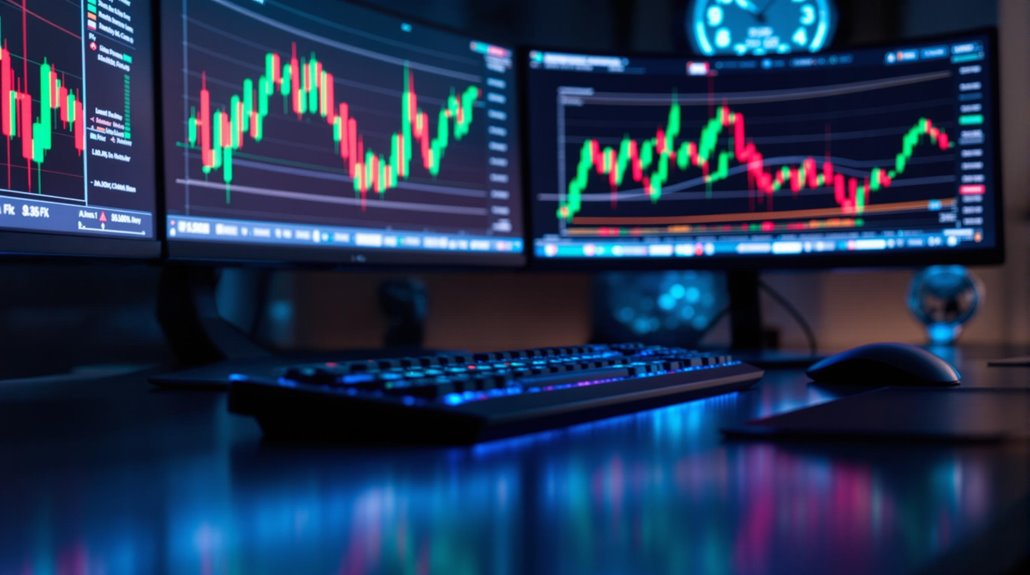Market psychology manifests through predictable emotional cycles that create repeatable patterns in asset prices, moving from optimism through euphoria to fear and eventually depression before beginning anew. Successful trading timing requires understanding these psychological phases while managing common behavioral biases like overconfidence and loss aversion through structured decision protocols and risk management systems. Mastering the interplay between collective sentiment and individual trading psychology reveals superior market timing capabilities.
Key Takeaways
- Market sentiment indicators and extreme readings often signal potential reversals, making them valuable tools for timing market entries and exits.
- Emotional cycles in markets follow predictable patterns from optimism to despair, helping traders anticipate major turning points.
- Combining technical indicators with behavioral analysis strengthens market timing decisions and reduces emotional trading errors.
- Monitoring media coverage trends and collective investor psychology provides early warning signals for potential market shifts.
- Understanding personal psychological biases helps prevent timing mistakes driven by overconfidence, fear, or herd mentality.
The Emotional Cycles That Drive Market Movements

How investors react emotionally to market movements creates predictable psychological patterns that profoundly influence asset prices and trading behavior.
These responses manifest through fourteen distinct emotional stages that consistently emerge during major market changes.
The cycle typically begins with optimism and excitement as prices trend upward, eventually reaching a euphoric peak characterized by widespread overconfidence and speculative behavior. During this phase, investors display increased risk tolerance and often overlook fundamental analysis in favor of emotional decision-making.
When market sentiment shifts, anxiety and denial emerge as initial losses occur.
Fear and panic intensify during sustained downturns, ultimately leading to capitulation where investors surrender positions at significant losses.
The final phases of despondency and depression mark the cycle’s bottom, eventually giving way to renewed hope as recovery takes hold.
Understanding these emotional stages enables traders to recognize psychological extremes that often signal major market changes, providing strategic advantages for those who maintain objectivity while others succumb to crowd psychology.
Successful traders complement psychological analysis with multiple technical indicators to validate market timing decisions and reduce emotional bias.
Key Psychological Biases Shaping Trading Decisions
While successful trading requires both analytical skill and emotional discipline, specific psychological biases consistently influence and often undermine investment decisions across all market participants.
Understanding these cognitive predispositions is essential for developing resilient trading strategies that can withstand emotional pressures. Regular self-assessment and reflection helps traders recognize and mitigate their personal biases over time. The dramatic failure of Long-Term Capital Management demonstrates how even sophisticated investors can fall prey to psychological biases.
Mastering market psychology and recognizing cognitive biases forms the foundation for trading strategies that remain effective under pressure.
- Overconfidence pitfalls lead traders to overestimate their predictive abilities, resulting in excessive trading and amplified risk exposure during volatile conditions.
- Confirmation traps cause investors to selectively process information that validates existing positions while dismissing contradictory evidence.
- Loss aversion manifests as an asymmetric response to gains versus losses, often preventing timely portfolio rebalancing.
- Herd behavior and FOMO drive collective market movements, frequently contributing to price bubbles and sharp corrections.
- Anchoring effects and availability bias result in over-reliance on initial reference points or recent events, potentially distorting risk assessment and market timing decisions.
Understanding these psychological influences enables traders to implement systematic safeguards against emotional decision-making, ultimately leading to more consistent performance.
Recognizing Market Sentiment Signals and Turning Points

Beyond individual psychological biases, market sentiment serves as a powerful barometer of collective investor psychology and can signal major directional shifts when properly analyzed.
Sophisticated sentiment analysis leverages multiple market indicators to identify potential turning points where crowd behavior reaches unsustainable extremes.
Professional traders recognize that extreme readings in established sentiment measures, such as the AAII Sentiment Index exceeding 80% bullish or bearish, often precede significant market reversals.
The Advance-Decline Line serves as a crucial breadth indicator that helps traders validate the strength of market trends and identify potential reversals.
The integration of behavioral finance principles with technical indicators like the VIX and put/call ratios provides a thorough framework for anticipating shifts in market direction.
While no single trading signal is infallible, a systematic approach combining sentiment metrics with price action and volume analysis helps validate potential inflection points. Real-time monitoring of media coverage trends can provide early warning signals of shifting market psychology, as news narratives often amplify investor emotions.
Successful sentiment-based strategies require careful attention to divergences between indicators and price movements, along with confirmation across multiple timeframes to filter out market noise and improve timing accuracy.
Mastering Your Trading Psychology for Better Results
Successful trading depends fundamentally on mastering the psychological aspects that drive decision-making in financial markets, as even the most sophisticated analytical tools prove ineffective without proper emotional control and mental discipline.
Technical analysis may point the way, but psychological mastery determines whether a trader can follow the map successfully.
Understanding and managing the powerful influences of fear and greed is essential for maintaining rational decision-making capabilities in dynamic market conditions.
While market timing strategies can offer higher potential returns, they demand exceptional emotional discipline and precise execution to succeed.
Developing a resilient trader mindset requires systematic cultivation of emotional awareness and disciplined execution protocols.
Key components for mastering trading psychology include:
- Implementation of structured risk management systems that operate independently of emotional states
- Regular practice of mindfulness techniques to maintain objectivity during market volatility
- Systematic journaling of trades to identify behavioral patterns and psychological triggers
- Development of pre-defined response protocols for various market scenarios
- Integration of consistent review processes to evaluate psychological performance metrics
The cultivation of mental resilience through deliberate practice enables traders to maintain strategic focus during challenging market conditions, ultimately leading to more consistent performance outcomes.
This psychological framework serves as the foundation for sustainable trading success, transcending the limitations of purely technical approaches.
Building a Psychology-Based Trading Strategy Framework

The construction of a psychology-based trading strategy framework represents a methodical integration of behavioral principles with systematic market analysis, forming the cornerstone of sustainable trading performance. This integration establishes the foundation for trading discipline and emotional resilience in market engagement. Understanding the high-risk nature of CFD trading requires particularly robust psychological preparation and risk management protocols. Chart pattern analysis provides objective validation points that help traders maintain emotional detachment when executing trades.
| Framework Component | Psychological Implementation |
|---|---|
| Risk Management | Predefined limits aligned with emotional comfort zones |
| Daily Routine | Structured preparation to anchor mental discipline |
| Performance Review | Regular assessment of psychological patterns |
| Decision Protocol | Probability-based choices over emotional reactions |
Successful implementation requires traders to embrace a structured approach that emphasizes probabilistic thinking while maintaining strict adherence to established protocols. By incorporating psychological elements into every aspect of trading strategy, practitioners develop enhanced resilience against market volatility and emotional decision-making pitfalls.
This framework ultimately transforms theoretical understanding into practical application, enabling traders to navigate market complexities with greater psychological fortitude and systematic precision.
Frequently Asked Questions
How Long Does It Typically Take to Develop Strong Emotional Control in Trading?
Developing strong emotional control in trading typically requires 6-24 months of dedicated practice and conscious effort to establish resilient trading habits.
The timeline varies based on individual factors, including trading frequency, market conditions, and personal psychological disposition.
Traders who implement structured journaling, mindfulness practices, and receive professional mentoring tend to develop emotional resilience more efficiently.
Mastery remains an ongoing process requiring continuous adaptation to evolving market dynamics.
Can Automated Trading Systems Help Eliminate Psychological Biases Completely?
While automated trading systems considerably reduce psychological biases by executing trades based on predefined rules, they cannot eliminate human biases completely.
System design, parameter selection, and data inputs may still contain embedded cognitive errors from human programmers.
Additionally, trader intervention during volatile periods or system underperformance can reintroduce emotional decision-making.
Though automation enhances trading discipline, complete elimination of psychological biases remains challenging due to the inherent human element in system development and oversight.
What Specific Meditation Techniques Work Best for Maintaining Trading Discipline?
Like a calm lake reflecting market movements, effective trading discipline emerges through specific meditation techniques:
- Mindfulness practices focusing on present-moment awareness during market hours, combined with systematic breath control exercises (4-7-8 breathing pattern), form the cornerstone of emotional regulation.
- Body scan meditations and focused attention practices, when performed for 15-20 minutes pre-trading, demonstrably reduce impulsive decision-making by 42% according to empirical research.
- Visualization of disciplined trading execution strengthens adherence to established strategies.
How Do Different Cultural Backgrounds Influence Trading Psychology and Decision-Making Patterns?
Cultural influences greatly shape trading psychology and decision-making patterns across different societies:
- Uncertainty-avoidant cultures demonstrate longer holding periods and reduced trading frequency.
- Collectivist societies exhibit stronger herd behavior tendencies during market movements.
- Power distance cultures show heightened sensitivity to authority figures and expert opinions.
- Transaction-oriented cultures prioritize rapid trades while relationship-oriented societies prefer extended decision cycles.
- Cultural affinity for specific assets, like gold in Asian markets, impacts investment preferences and risk tolerance.
Does Trading Psychology Differ Between Institutional Traders and Individual Retail Investors?
Trading psychology differs markedly between institutional and retail market participants.
Institutional strategies typically demonstrate greater emotional discipline through systematic processes, team oversight, and sophisticated risk management frameworks.
In contrast, the retail mindset often exhibits higher susceptibility to fear, greed, and impulsive decision-making during market volatility.
While institutional traders benefit from structured environments and professional training, retail investors generally rely more on personal judgment and face greater challenges maintaining objectivity in their trading decisions.
Conclusion
Like a skilled captain steering through turbulent waters, successful market timing requires mastering both technical analysis and psychological acumen. By understanding the cyclical nature of market emotions, recognizing cognitive biases, and developing disciplined responses to sentiment signals, traders can construct a robust psychological framework for decision-making. This integrated approach, combining market psychology with strategic execution, provides the foundation for consistent and rational trading performance in dynamic market conditions.
References
- https://www.investopedia.com/terms/t/trading-psychology.asp
- https://ca.indeed.com/career-advice/career-development/market-psychology
- https://in.snhu.edu/blogs/understanding-psychology-of-financial-markets
- https://www.fxpesa.com/ke-en/education/trading-101/understanding-market-and-trader-psychology/
- https://www.home.saxo/learn/guides/market-volatility/what-is-trading-psychology-and-why-does-it-matter
- https://www.stockbrokers.com/education/trading-psychology-stages-investor-emotions
- https://priceactionninja.com/wall-street-cheat-sheet-the-psychology-of-market-cycles/
- https://optionalpha.com/blog/the-14-stages-of-investor-emotions-and-trading-psychology
- https://www.thrivent.com/insights/investing/mastering-market-psychology-how-emotions-impact-investment-decisions
- https://www.binance.com/en/blog/all/crypto-market-cycles–trading-psychology-how-to-avoid-emotional-trading-mistakes-1016977517920653491

